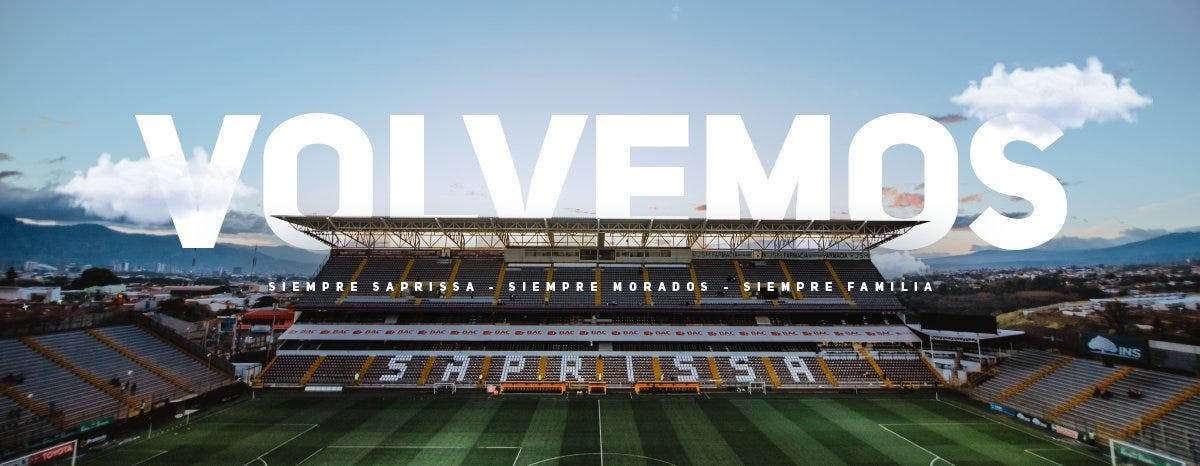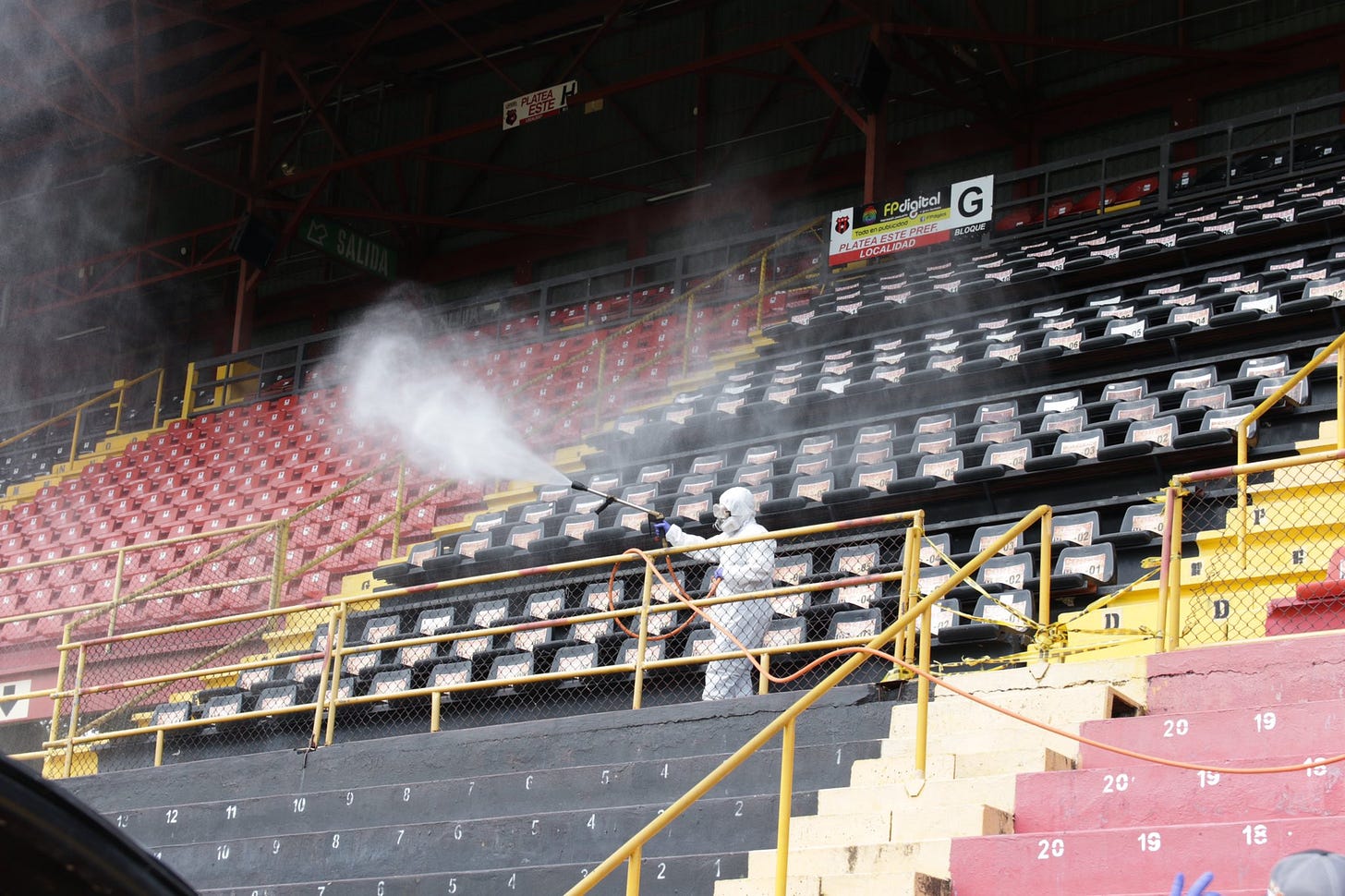🇨🇷 - Why the Costa Rican league feels ready for next week's return
The presidents of two of the country's biggest clubs gave me their perspectives.

They back (Credit @SaprissaOficial)
Costa Rica’s top division will become the first league in the region to restart after stopping because of the coronavirus pandemic, with the ball rolling again Tuesday.
How have they done it? Why will we be able to enjoy Saprissa against Herediano or Cartaginés against Liga Deportiva Alajuelense this week as other leagues in the region weigh playing in a controlled bubble or scrap the season entirely?
For Saprissa president Juan Carlos Rojas and Liga Deportiva Alajuelense president Fernando Ocampo, the answer is relatively straightforward in a time when few things seem cut and dried. Their government implemented strong measures to stop the spread of COVID-19, citizens followed the measures and now the country can think about things aside from the virus.
“I think first you have to start talking about the way Costa Rica has dealt with the pandemic,” Ocampo told me this week. “I think the strategies implemented by the government and the ministry of health have been very effective. We’ve achieved the flattening of the curve, and the way that it’s been done has allowed us to be in a very good public health situation when compared to other countries.”

LDA’s Estadio Alejandro Morera Soto undergoes fumigation (Credit: @LDACR)
Costa Rica, a nation of 5 million, announced its ninth coronavirus-related death Friday afternoon and hasn’t had a day in the last 30 days in which it announced more than 15 new cases of the virus. More Costa Ricans have died in the United States because of COVID-19 than have died in Costa Rica.
“I think that there are people who might not know about the situation in Costa Rica and some of them might be thinking it’s a bit rushed to get back to soccer here, but what I’d say is that we’ve been very, very careful and that soccer is coming back here because of the particularity of how the the country has been able to positively face COVID,” Rojas told me Friday.
Beyond the strong government response, club presidents like Rojas and Ocampo were laying the groundwork for a return almost as soon as the league shut down. More than six weeks ago, they formed a medical committee that included virologists and sports medicine professionals to draw up a protocol both for the return of training and the later resumption of matches. Since May 1, teams have been training under regulations approved by the country’s Minister of Health that involves getting their temperature taken upon arriving to the facility each day, working in small groups and has stringent requirements on who can be in areas like locker rooms and when they can be there. Only in the latter stages of this week did the first ‘integrated’ practices take place.
“Those protocols were very, very strict,” Rojas said. “We went over them with the authorities. I think we should a lot of commitment, a lot of professionalism and seriousness in this process and I think that also helped for the authorities to put soccer as one of the activities to open first in this process.”
Even with the low number of cases in Costa Rica relative to other countries, the matches will remain behind closed doors for the rest of the season. That’s not ideal, but reflects the current reality.
“Obviously, it’s not the same, but it’s what there is,” Rojas said. “It’s not something that is in our control or something we can choose. I think it’s obviously better to play soccer behind closed doors and allow everyone at home right now to see the game and everything that implies for the industry of soccer against not playing at all. So, I don’t love it, but it’s the best alternative there is.”
And while the two giant clubs perhaps had more latitude than some of the smaller institutions in the country, there were real concerns about the long-term future of the Costa Rican league were things not able to get back on track.
If it didn’t restart in May, Rojas said, it was unlikely to restart at all. With Concacaf advising leagues to look to wrap up by the end of June, players struggling to maintain fitness on their own time and the economic realities of trying to get by without games, it was critical for the presidents to find a solution. They met once a week, sometimes more, and eventually devised the current schedule which will see the remaining seven matchdays plus six playoff matchdays take place in just over a month.
Clubs worked with the Players’ Association in March to adjust their salaries and help buy them some time, with the players agreeing amiably as the clubs avoided furloughs. (“There are a lot of families who depend on this,” Ocampo said. “Unlike maybe in other countries, we did this in a very negotiated way, together with the players,” Rojas noted.)
While teams are hardly back to their initial budgets, the league’s teams now are fielding inquiries from other countries in the Americas about television rights deals and are looking to attract new sponsors (including looking to get legislators to repeal a prohibition on alcohol brands sponsoring teams).
The TV revenue coming in is “fundamental,” Ocampo said. “I think our gas, here in Costa Rica as clubs, was running out. We didn’t have a lot more space. If soccer didn’t come back, we would’ve probably had to let go of a lot of players.”
In the United States, fans can download the TDMas app and pay a $5 monthly fee to catch the majority of the league’s teams, including Saprissa, LDA and Herediano. (Sorry if you jumped on the Jicaral bandwagon after going through that flow chart).
There is a desire to get things going again and to give people in Costa Rica and throughout the region something to smile about, but both presidents know there will be people watching closely to see if anything goes amiss.
“I think we’re going to fill the entire country with a lot of joy,” Rojas said. “I think that here soccer can serve in a difficult moment like we’re going through as a country as a form of entertainment, fun and give us something happy to be thinking about. That’s the role soccer can play. So, I’m happy the uncertainty about the tournament has ended and that teams can get back on the field.
“There’s also a bit of anxiety, if I can call it that, because we’re going through different things. We’re going to maintain very strict protocols. The players are going to have to change some of the behaviors, things that they now can’t do. There’s the uncertainty that always will be there of if a player is contagious and the implications this can have on the tournament, so although on one hand I’m very happy, I also know the responsibility this carries and there is some degree of uncertainty that will persist until there can be a vaccine.”
In the midst of that uncertainty and anxiety, the Costa Rican league will look to bring back some level of normalcy.




